In 2014, a new big budget American version of Godzilla was released. Like the original versions and the hated 1998 film, the latest film had the big fellow stomping through a city and reflected the audiences’ collective fears or sense of security.
Godzilla – 2014. Directed by Gareth Edwards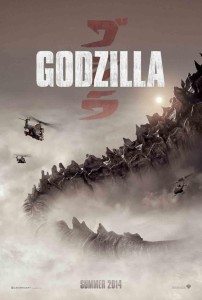
Godzilla was reintroduced to American audiences 16 years after the Emmerich and Devlin production. In an age of rebooted franchises and product familiarity being king for mainstream Hollywood movies, a more faithful Godzilla production seemed like a no brainer. When Sony Pictures allowed the rights to expire, they were scooped up by Warner Brothers who produced the film with Toho, the studio that created the series.
The new film would be Toho approved and made with the fans in mind. The internet reigns supreme. Rabid fans are to be catered to, not ignored. Legendary Pictures, who produced The Dark Knight among other blockbusters, spearheaded the production. Monsters director Gareth Edwards took the helm. He was an unconventional choice, but after Peter Jackson’s success with The Lord of the Rings, unconventional became conventional.
And while Warner Brothers and Toho Studios wanted to distance themselves from the 1998 film, the story of the new film was remarkably similar to its maligned counterpart.
- Both feature grainy footage of nuclear explosions during the opening credit sequence. Some of the same shots were actually duplicated. The parallels do not end there.
- Both feature the military following an unseen monster swimming towards the coast of the United States.
- Both include a scene where a gigantic wreck is examined near the sea.
- Both have a young attractive character figuring out that a monster is heading to a city to reproduce.
- Both have the military completely confused and a general ordering that the monster be led into the middle of the city.
- Both have a mysterious character who seems to know a lot about the plot played by a terrific actor with a thick accent who, in the end, offers nothing to the story. That part was played by Jean Reno in 1998 and by the always reliable Ken Wattanabe in 2014.
- Both feature a lot of buildings being destroyed and a triumphant ending despite billions of dollars worth of damage.
- And, amazingly, both have a scene where the young protagonist of the story has a stare down with Godzilla.
Pointing out the common points in the stories is surprising when you take the tone of the two movies into account — they could not possibly be more different.
The norm of franchise pictures in the new millennium is to take the source material seriously and treat it with the weight that would normally be reserved for Biblical epics.
The goal is to appeal to the hard-core fans and hope that their enthusiasm would generate interest. Movies have become so expensive and home entertainment systems, from HDTVs to tablets, were so high quality that the only reason to go to the theater would to be part of an event.
The 2001 releases of the first Harry Potter film and the beginning of The Lord of the Rings trilogy changed the tone of blockbusters and Hollywood tentpoles. They would now have gravity, be faithful to the source and spend time feeding the proverbial Comic Con beast.
Of course another event took place in 2001, just a few moments before Dumbledore and Gandalf made their debuts. The September 11th attacks pierced a hole in American imperviousness. Suddenly the destruction of national landmarks, as in Independence Day, did not seem as fun or as escapist. A common refrain heard from people describing the horrors of that day was “it looked like it was a movie.”
Evidently Emmerich and Devlin got it right.
For the first time since the Cold War, there was a common fear among American movie audiences. The motif of waking up on a normal day only to experience a terrifying and deadly surprise that not only puts the characters in peril but also confuses them became a common template for American movies.
Horror films were no longer the self parody of Scream but the brutal, realistic and deadly confusion of Saw and Hostel.
Villains in movies were no longer comedic nor someone to try to understand, like Hannibal Lechter. Now they were pure evil and beyond our comprehension, like Javier Bardem’s terrifying performance in No Country for Old Men.
Compare Jack Nicholson’s scenery chewing winking to the camera Joker in 1989 to Heath Ledger’s deadly and unpredictable turn in The Dark Knight to see the difference between pre- and post-September 11th blockbusters.
9/11 imagery became common place in sci-fi and action blockbusters, just as Cold War messages found their way into films from generations past. From The War of the Worlds to Man of Steel, images that mirror the World Trade Center crumbling and the people running for their lives and covered in ash create a quick, and borderline offensive, jolt to the audiences’ sense of peril. Even Star Trek, which offered an optimistic view of a post-Cold War perspective, turned to a September 11th plot for Into Darkness.
But Godzilla.
Godzilla stayed true to this era’s Ground Zero obsession. Bryan Cranston and Juliette Binoche open the movie dropping their kid off to school before heading to work in a Japanese nuclear power plant on a pleasant day. Then a surprising event causes the building to crumble, which the kid sees from his school window, and Cranston has a moment where he watches his wife die before his eyes, helpless to save her.
They did everything but pan to a calendar that reveals the date as September 11th.
But unlike the other World Trade Center obsessed blockbusters, this incarnation of Godzilla takes it to a further step. It is practically a love letter to 9/11 truthers.
After the power plant disaster, the film jumps ahead about a dozen years (roughly the same amount of time between 2001 and the release date of the movie.) The little kid has grown up to look like actor Aaron Taylor-Johnson and is in the military. He has a wife and kid and lives in an unreasonably large home in San Francisco.
His pop still looks like Bryan Cranston, who has gone full-truther crazy. He does not accept the official explanation of the destruction of the power plant which led to the quarantining of Janjira. He feels there is something being hidden.
Cranston’s apartment in Japan has clippings and charts covering every inch of his wall as he remains in contact with fellow conspiracy theorists on the internet. His incredulity of the destruction analysis echoes truthers asking what took down Building 7.
Cranston and Taylor-Johnson go into the supposedly contaminated city of Janjira and discover that there is no radiation issue. Cranston (and by extension the truthers) were correct! Questioning authority was the right thing to do. They WERE hiding something, man! Keep digging! Find the truth.
Sadly Cranston dies before the movie gets going. Instead of following a truther with evidence on his side, we are stuck watching a bland handsome military man hoping to stop monsters.
By the way, Godzilla was not the cause of the destruction. It was a giant Starship Troopers bug-looking thing who was communicating with another one who lived in Las Vegas… or something.
Soon Wattanabe shows up. He is named Serizawa as a nod to the original movie. If only they gave him a patch for his eye. A general who looks and sounds like David Straitharn collecting a check gives orders and calls the monster a MUTO (Massive Unidentified Terrestrial Organism.)
Godzilla swims around and shows up to fight one big bug in Honolulu while another monster wrecks Las Vegas. Naturally, everyone, including the humans and kids, all end up in San Francisco.
The problem with making a Godzilla movie with September 11th overtones is the fun of watching a city being destroyed is removed totally by, well, reality.
Godzilla fights the two bug things before they can get it on. They crush buildings and the military tries to retaliate along the way. Godzilla, now back with his fire-breathing abilities, even does a few cool moves to take out the bugs. But these scenes are punctuated with reality.
Buildings are destroyed as the monsters fight. Instead of the gleeful smash-up fun of Destroy All Monsters or the bloodless carnage of the Emmerich-Devlin film, this version is clearly not in an evacuated city. People run screaming from the falling buildings and glass. Eventually fliers are put up all over the city, asking for the location of lost people, much like those that covered New York throughout September of 2001.
The main characters wring their hands. And there is some subplot revolving a war head that needs to be disarmed. All the while, I kept wishing Cranston was still in the film to give the human scenes a quirkier edge. Or maybe one of The Simpson’s stars could have lightened things up a touch.
Soon San Francisco gets leveled and the loss of life and property soars beyond calculation. (On the bright side, following this film’s destruction, you might be able to afford an apartment on Russian Hill.) Godzilla kills the MUTOs (a name that wore on me after a while) and swims back to sea with a military escort. The news declared him “the savior of the city.”
Much like Man of Steel, the so-called hero did as much damage and destruction as a nominal villain. “You destroyed my home and stomped on my family. THANKS GODZILLA!”
Unlike the aborted follow-up to the 1998 film, this production will have a sequel.
Hopefully the franchise will lighten up much as the original Japanese films did after time. The original was rooted in a collective Japanese horror of atomic power and evolved into something about a dinosaur superhero. If the new series sheds its September 11th anxiety and relaxes, our scale-covered star could get the big budget treatment he so richly deserves.

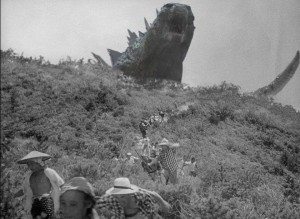
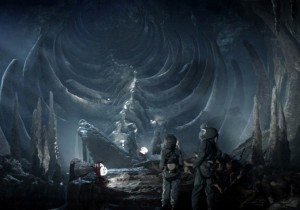

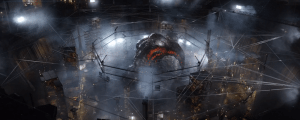
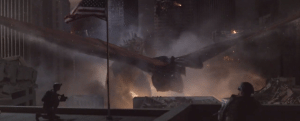
I thought this was okay. I liked the sense of scale he gave the monsters but I agree that the main lead was a nothing character played as bland as possible.